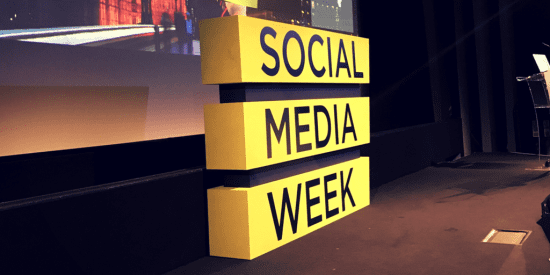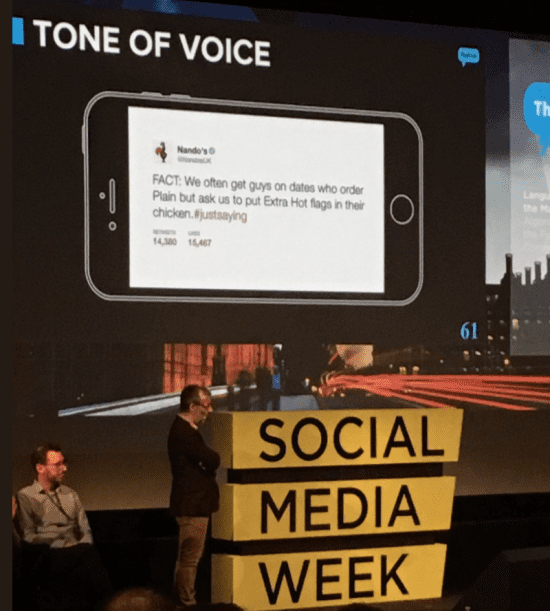Catch up on whats been happening at Social Media Week London 2017
Social Media Week London is a week long conference that focuses on the latest trends in communication, engagement, VR, Mobile, influencer marketing, and of course social media. Over the three days, SMW London holds over 50 sessions and workshops, with brands such as Buzzfeed, Facebook, and ITV.
Over the next three days, I will be keeping you all updated on what’s happen and the key takes aways from each talk. Check back each day for an overview of the day’s talks.

Day 1
The Speed of Feed, hosted by Facebook, Facebook
The day kicked off with Kat Hahn, from Facebook who focused on ‘The Speed of Feed’. She first pointed out that scroll through 300 feet of content per day. How can brands start building ideas that work for the speed of feed? She suggested there are three modes of consumption on social media and what captives them?
- ‘On the go’ – 70% – This is immediate content. Short and snappy content that consumers would view but not be too invested in
- ‘Lean forward’ 20% – This is interactive content where consumers are Looking for something to watch and something captures your attention.
- ‘Lean back’ 10% – immersive content, longer and goes into detail. Consumers are willing to watch something for a long period of time
They estimate that 70% of people are on-the-go and looking for immediate content compared to 10% in lean- back mode.
Key take away: Not doing short video is not an option
Masters of Storytelling: How NatGeo Engages 350 Million Fans on Social, National Geographic
When you think of National Geographic, best social media performance doesn’t typically come to mind. But National Geographic is one of the most engaged with brands on Instagram with 107.2M followers and receives thousands of engagements per day. Nadine Heggie, VP of Brand Partnership talked through their social strategy and key to success.
How do you get people to stop? ‘By staying true to your brand, being timely with content, using the power of wow and wonder, and embracing new technologies to tell stories.’ She believes that collaboration is one part of their success story, by finding the right story tellers to represent their brand.
Key take away: The future of social is through visual storytelling and that social is always on.
Don’t Be Socially Awkward, Havas
Social Strategist, Anna Russett focused her talk on why it’s so hard for advertisers to communicate through social media. Her reason was that it’s so over done. Social is social for a reason, therefore, it can be hard to integrate advertising. In order to take part in social conversation, we have to do it in a meaningful way and not just disrupt your followers feed. She quoted ‘You can’t just make ads that speak at people anymore because people can now talk back’.
She also pointed out that she would rather have negative interaction than none at all, at least what you have produced has made them feel something. She strongly advised brands to stop using general and meaningless hashtags, if the majority of your likes are coming from a bunch of bots then they are meaningless. Find the meaningful hashtags and just use a couple that matter.
Key take away: If you’re going to shout about your brand on social media, shout about it in a meaningful way
How Data Driven Creativity Will Be The Key To BuzzFeed’s Future Success, BuzzFeed
In less than a decade BuzzFeed has become a global network for news and entertainment, that generates nine billion content views per month. Richard Alan Reid, Executive Creative Director at Buzzfeed gave his insight on how they do this. He first spoke about how they test and mold their content until they found the best option, and this was a lengthy process of trial and error. Once they found the best option for their new content they would focus in on tone. He quoted ‘We obsess with the local tone of the market so we can adapt our content based on the data from that area’.
Once they understand their tone and how to market their content, they leave the rest to their followers and fan. They have built a solid community who like, comment and share their content. These followers have become their ambassadors, they do the sharing for them. what ever you capture their attention for you have to follow through with that.
Key take away: You don’t want to interrupt the content people love. You want to be the content people love
Creating Social Gold: The Art of Platform Specificity, That Lot
‘The average person spends 1 hour 16 minutes on social platforms and in this time you have to try and stop that thumb’. In order to stop the thumb they offered a couple of tactics that they have found helpful. They focused on four platforms and suggested the following:
- Make sure your content is relatable they post short videos and gain thousands of organic views.
- Use short and humorous video to gain organic views
- Your content should work in isolation not just the fans of the brand
- ‘Design for sound off, delight with sound on’ – more people are starting to watch with the sound on, it’s still valuable.
- Use more video on Instagram, the number of videos produced on Instagram is growing by 4x YoY
- There are 250 million stories everyday, make yours count. Create a strategy around your story and invest time and thought.
- The more personality your content has, the better it is
- Shorter tweets under 100 character often perform better
- Users love human truths and authenticity. Don’t be afraid of humor, he gave a great example from Nandos

Snapchat
- Snapchat doesn’t require your content to be as polished as other platforms
- Experiment with geo filters and stories – If your wanting to reach a millennial audience this is the place you need to be
- Try using a film series, offer something your followers can tune into and create stories users can get invested in
Key take away: Don’t be afraid to be more human on social media
“Alexa, What Does the Future of Marketing Look Like?”: How Brands Can Leverage Audio to Reach Consumers, VaynerMedia
Through out the day, I noticed one topic that was popping up- voice search. I decided to attend Patrick Givens, Head of Smart Innovations talk on the audience on the other side of voice search. He believes your brand could be having a conversation with millions of consumers right from their own homes via a smart device. As more homes introduce Amazon Echos, Google Homes, and Apple HomePods brands need to start to look at what this means for them.
Givens provides two examples of how these devices could be used by brands in the home. The first was a Johnnie Walker Digital Mentor and the second GE’s Labracadabra science experiment assistant.
Key take away: He left us with a question – ‘Will you be ready to respond?’
Stay tuned for the next 2 days of SMW, as I cover the best speakers and 2017 trends for social media.
